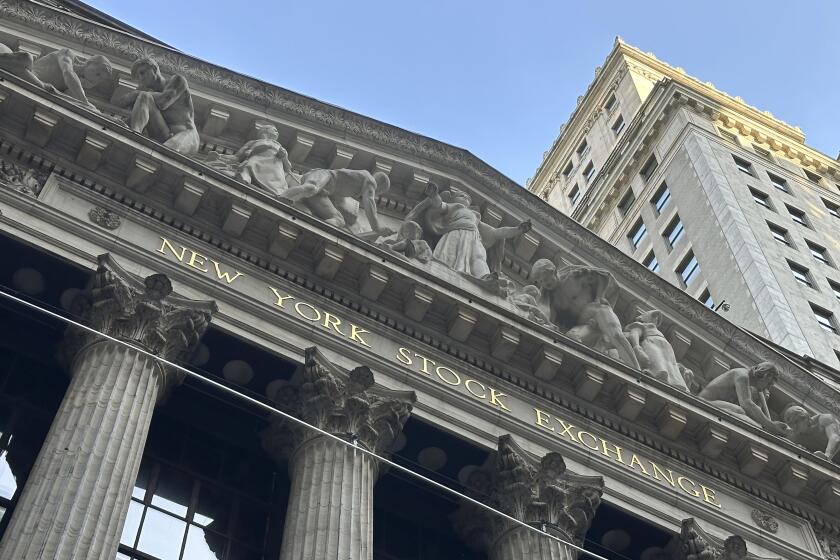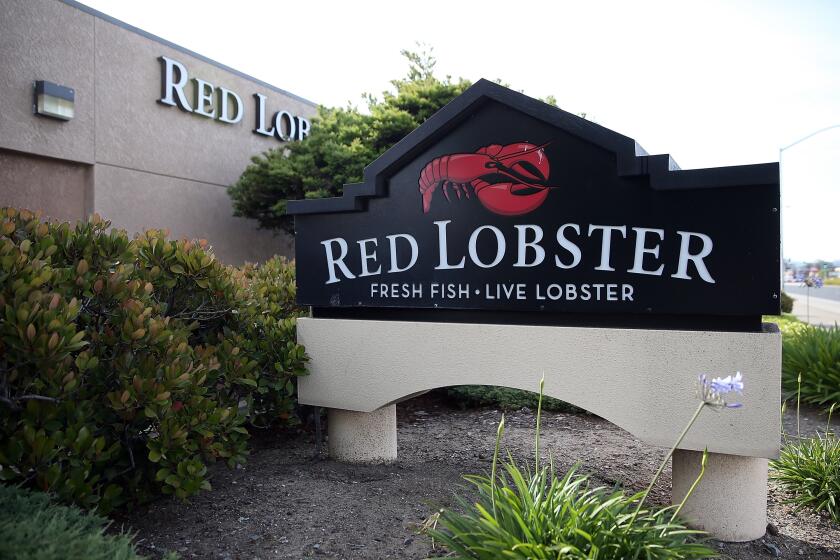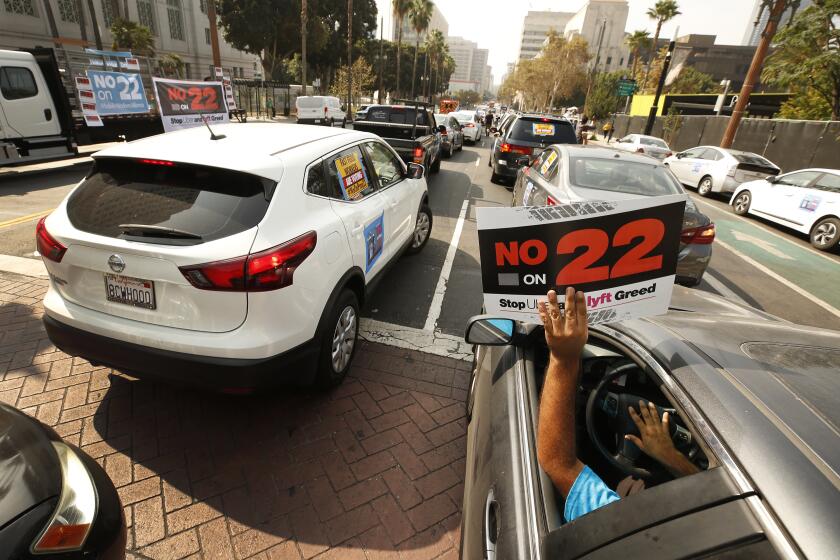COLUMN ONE : An Empty Feeling All Around : Commercial real estate in the region is at the end of a development orgy. Buildings ‘go dark’ as rents and values plunge. A Long Beach firm’s collapse leaves thousands with losses--and a lesson.
Michael J. Choppin once radiated a confidence bordering on smugness that accompanied two decades of success in building offices, shops and apartments across Southern California.
Not only did his developments consistently churn out fat returns for thousands of small investors, he liked to say that his Long Beach company, IDM Corp., had an uncommon ability to weather any economic climate.
“We’ve never lost anybody a penny,” he bragged a few years ago.
The confidence has evaporated now, replaced by the humility that invariably results when bust follows boom. IDM is clawing for its life today in bankruptcy court, where it sought refuge this summer.
A depression-like pall has firmly settled over commercial real estate in Southern California, and IDM is arguably its most visible and compelling casualty. The firm has about 12,000 investors--all from California, many retirees--facing potential losses approaching $300 million.
“They sold an awful lot of stuff to an awful lot of widows,” said Robert M. Coleman, a personal financial adviser in Pasadena.
IDM blames its problems on a depressed economy, saying it was undone by “uncontrollable market factors” that constricted its income and gnawed away at the value of its investment properties, bankruptcy records show.
Many investors, though, charge that IDM’s actions belied its carefully polished reputation as a prudent investor. Instead of investing sagely, they say, IDM borrowed excessively on properties now worth a fraction of their original values.
Whatever the cause, IDM’s underlying problems are by no means unique. Many commercial property owners and developers in Southern California are in deep trouble today because rents, values and occupancy rates have headed due south.
Downtown Los Angeles is starting to resemble Houston in the 1980s, when vacant office space abounded because of overbuilding and a collapsed regional economy. More than one of four offices in downtown L.A. now stands vacant, the highest rate in its modern history, property brokers say.
Whereas Houston had its “see-through” buildings--new office towers that had no occupants--Los Angeles now has older office structures “going dark,” meaning they no longer have any tenants.
Two office buildings stand vacant in the heart of downtown Los Angeles at 6th and Flower streets. Both need expensive sprinkler systems and their owners, foreign-owned banks, are mulling what to do.
“If they were horses, you would shoot them,” said George Salem, a banking analyst for Prudential Securities in New York.
Fueled by easy money from domestic lenders and foreign investors, Southern California’s commercial real estate market underwent an unprecedented boom in 1980s that resulted in an orgy of overbuilding and a prodigious glut in office and retail space.
Property experts estimate that it will take up to six years for the regional commercial market to absorb the excess space. Meanwhile, office rents have plunged to 10-year lows and the values of some buildings have fallen 50% or more.
According to TRW REDI Property Data, a research firm in Riverside, average office building values in downtown Los Angeles and the Mid-Wilshire area fell 25% between 1988 and 1991. One building at 9th and Broadway sold this year for $5.5 million--one-third its original value.
Rising office vacancy rates are a telling indicator of the massive corporate and government cutbacks occurring from San Diego to Los Angeles. More than one in three offices stands empty on Century Boulevard near Los Angeles International Airport, a traditional office home for aerospace and defense workers.
“There are a lot of areas of town where whole industries are out of gas,” said Eugene F. Page, a commercial broker in Los Angeles. “Who is going to fill the space vacated by Hughes and Lockheed? Someone will eventually, but who knows when that will happen.”
Banks, insurance companies, private investors and government agencies typically absorb the losses on these investments. When the properties falter, they are usually reclaimed and resold at bargain-basement prices.
In IDM’s case, the main losers are the investors, who began flocking into its investments starting in the mid-1980s. IDM raised development funds through public partnerships typically sold through brokerages to retirees and professionals.
IDM’s rise and fall provides an unusual inside look--documented by lawsuits and bankruptcy records--at a major commercial developer that badly misread the real estate market and is now scrambling to salvage what is left of its crumbled empire.
“IDM was a victim of its own success,” said Dallas attorney Robert C. Feldman, the firm’s bankruptcy lawyer. “For 22 years they were successful, and they ended up attracting more money than they could (wisely) spend.”
It is also a personal story about Choppin, who founded IDM in 1969 and is the sole shareholder. Driven, aloof and intensely private, Choppin emerged in the 1980s as a leading developer in Long Beach, with a reputation for quality construction done with style.
“He did things in Long Beach no one else would have done,” said Vance Caesar, former general manager of the Long Beach Press-Telegram.
With only a high school education, Choppin is very much self-made and self-taught. Born in Great Britain 54 years ago but raised in Long Beach, he began as a real estate agent in the city’s upscale Belmont Shore neighborhood in the 1960s.
Three decades later, when Choppin’s empire had collapsed, it echoed through Long Beach like an economic sonic boom. Many IDM investors live there, while several of its office developments dot the city’s once-shabby downtown business district.
Investors had flocked to returns as high as 15%, but many apparently gave scant thought to the underlying risks. “I just never thought Southern California real estate could go sour like it did,” said one hapless investor, Tom Bybee.
The collapse has unmasked business practices at IDM that were never questioned when real estate values were going up, and IDM is fending off allegations that it badly misled investors about its deteriorating financial condition.
Choppin declined to be interviewed, but a company spokesman said that he “categorically denies” that he misled or deceived investors. “These investments were sold through broker/dealers to people who had to sign they knew what the risks were,” Jim McMillan said.
At its zenith, IDM and its partnerships were developing $250 million in property a year. Choppin’s projects grew increasingly ambitious in scope and cost as the years passed and his success increased.
The brightest jewel in Choppin’s development empire is the 27-story Greater Los Angeles World Trade Center that he built in partnership with Kajima Corp., the Japanese construction giant. The building, which opened in 1989, has been a financial success and cuts a striking silhouette on the Long Beach skyline.
But it was not the World Trade Center that endeared Choppin to so many small investors. Rather, they adored the returns that IDM offered on dozens of garden-variety office and apartment buildings.
Geographically, its developments ranged from an apartment building in Oxnard to a shopping center in Laguna Hills, but most of the developments were concentrated in and around Long Beach.
With real estate constantly inflating in value, it ensured healthy profits, a constant flow of checks for investors and a steady stream of new projects in which to invest. Choppin “rode the rising market and he was very good at it,” said Richard Wilson, senior vice president of Harbor Bank in Long Beach.
When property values leveled off and began falling in the late 1980s, Choppin continued to aggressively expand and raise money even as the more prudent developers began to scale back, his critics say.
He told colleagues that he would survive the coming hard times as he had previous recessions. This time around, he would de-emphasize office construction and pursue “development opportunities” in apartments and retail, he told investors in 1990.
Instead, the economic decline, punctuated by huge losses in aerospace and defense jobs in the Long Beach area, proved far more serious than Choppin anticipated. Property values on IDM’s real estate plunged and so did rents.
All pretense of success and optimism vanished on July 24, 1991, when IDM announced that it had suspended distribution payments to its investors because of the deteriorating economy and an inability to borrow money from its traditional sources--banks, the Japanese and small investors.
The slide accelerated in 1992 as IDM was jolted by several investor lawsuits, including one filed by about 300 plaintiffs accusing Choppin and his affiliated companies of massive civil fraud for the manner in which they sold partnerships to the public. The Chicago law firm of Beigel & Sandler filed the suit.
Reeling under the accusations and cut off from its sources of cash, IDM and 25 of its affiliated partnerships filed a Chapter 11 bankruptcy petition four months ago, listing debts of more than $400 million. Chapter 11 shields a company from its creditors while allowing it to reorganize its operations.
IDM now says investors will receive more than half their money back if they allow time for real estate prices to rebound in the years ahead. However, the company says, investors would receive little or nothing back if the properties were liquidated at today’s prices.
IDM’s critics say that the problems go well beyond depressed real estate. According to the Beigel suit, IDM inflated the value of its properties and overencumbered them with multiple mortgages.
One IDM office building in downtown Long Beach is worth less than half its $22-million appraised value, the suit said, while $9 million in mortgages on another office building in North Long Beach is more than three times the actual market price.
According to another investor lawsuit, IDM continued to raise partnership money from investors well into 1991 even as “it teetered on the brink of bankruptcy.”
Public records also show that IDM informed the Securities and Exchange Commission in April, 1991, that one of its affiliated income partnerships had “terminated” its accounting firm, but denied that the parting had anything to do with important bookkeeping issues, public records show.
The accounting firm, KPMG Peat Marwick, quickly corrected the report, telling the securities commission that it wanted IDM to set aside reserves for loan losses because it believed that the firm’s properties were overvalued.
Not surprisingly, Choppin found himself under heavy fire and his popularity plunged. Some investors were angry when he cut his base salary only 20%--to $320,000--after IDM filed for bankruptcy protection.
Under pressure from investors, he agreed to another pay cut--to $224,000--and the elimination of other management perks, though he retained an $18,000-a-year car allowance. He has also agreed to turn over ownership of IDM’s assets to investors.
Choppin has the support of some faithful investors who argue that he is the best hope for getting their money back. The proposed reorganization estimates that investors will eventually get back 55 cents for every $1 invested.
One supporter is a retired state appeals court judge from Bakersfield, Roy J. Gargano. As a longtime large IDM investor, Gargano has sharply attacked Beigel & Sandler for the aggressive manner in which it attracted plaintiffs for the lawsuit.
In a letter to fellow investors last May, Gargano argued against joining the suit, calling it “counterproductive and a giant step in the wrong direction.”
Herbert Beigel, a partner at the firm, dismissed Gargano as a long-time “IDM apologist.”
Gargano declined to be interviewed.
This kind of sniping has caught many investors in the middle. Though they have not joined the suit, they are watching with great anxiety and wondering how much of their investments they will recoup.
“What do you think I should do?” Bybee asked a reporter plaintively.
Bybee has known the IDM boss since the 1960s, when Choppin sold him a house in Long Beach. As the years wore on, Bybee’s faith in Choppin grew as he invested funds in projects that consistently paid high returns.
Then, when Bybee retired from GTE Corp. in 1987, he put most of his life savings--an amount so large that he will not disclose it publicly--in IDM investments. “I just had confidence in him,” he said. “I put my money with him and let him have it.”
Now, Bybee said: “It makes me sick when I think about it.”






